Complete Solutions to SECTION -2 COMPREHENSION TYPE of chapter JEE ADVANCED of Class 12 book with complete answers and questions
| Class 12 | PHYSICS |
| Chapter | JEE ADVANCED |
| JEE ADVANCED | SECTION -2 COMPREHENSION TYPE |
| Number Of Questions | 6 |
| Academic Year | 2023-24 |
In Fig., a container is shown to have a movable (without friction) piston on top. The container and the piston are all made of perfectly insulating material allowing no heat transfer between outside and inside the container. The container is divided into two compartments by a rigid partition made of a thermally conducting material that allows slow transfer of heat. the lower compartment of the container is filled with 2 moles of an ideal monoatomic gas at 700 K and the upper compartment is filled with 2 moles of an ideal diatomic gas at 400 K. the heat capacities per mole of an ideal monoatomic gas are `C_(upsilon) = (3)/(2) R and C_(P) = (5)/(2) R`, and those for an ideal diatomic gas are `C_(upsilone) = (5)/(2) R and C_(P) = (7)/(2) R.`
Consider the partition to be rigidly fixed so that it does not move. when equilibrium is achieved, the final temperature of the gases will be
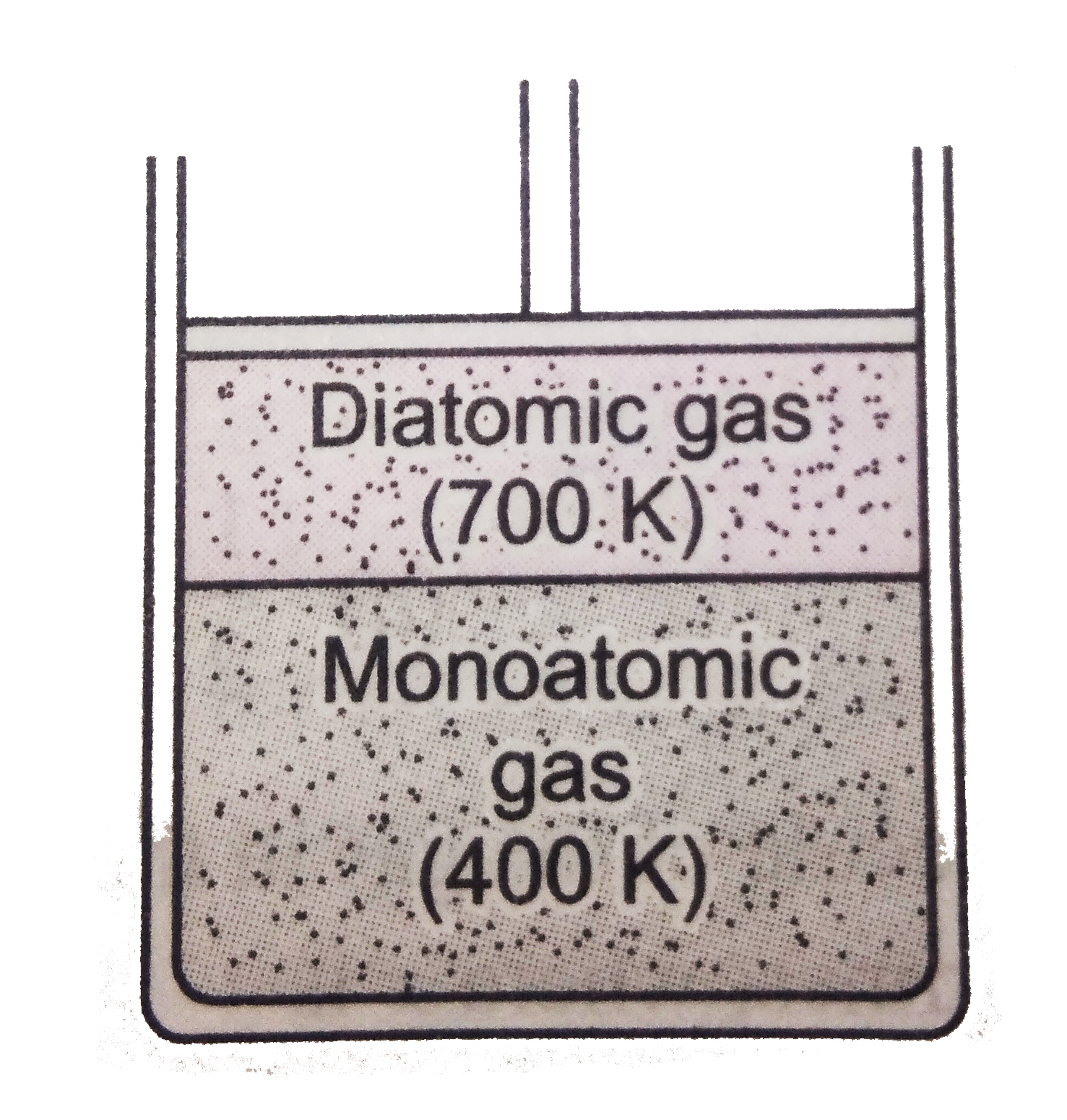 05:45View Solution
05:45View SolutionIn Fig., a container is shown to have a movable (without friction) piston on top. The container and the piston are all made of perfectly insulating material allowing no heat transfer between outside and inside the container. The container is divided into two compartments by a rigid partition made of a thermally conducting material that allows slow transfer of heat. the lower compartment of the container is filled with 2 moles of an ideal monoatomic gas at 700 K and the upper compartment is filled with 2 moles of an ideal diatomic gas at 400 K. the heat capacities per mole of an ideal monoatomic gas are `C_(upsilon) = (3)/(2) R and C_(P) = (5)/(2) R`, and those for an ideal diatomic gas are `C_(upsilone) = (5)/(2) R and C_(P) = (7)/(2) R.`
Now consider the partition to be free to move without friction so that the pressure of gases in both compartments is the same. the total work done by the gases till the time they achieve equilibrium will be
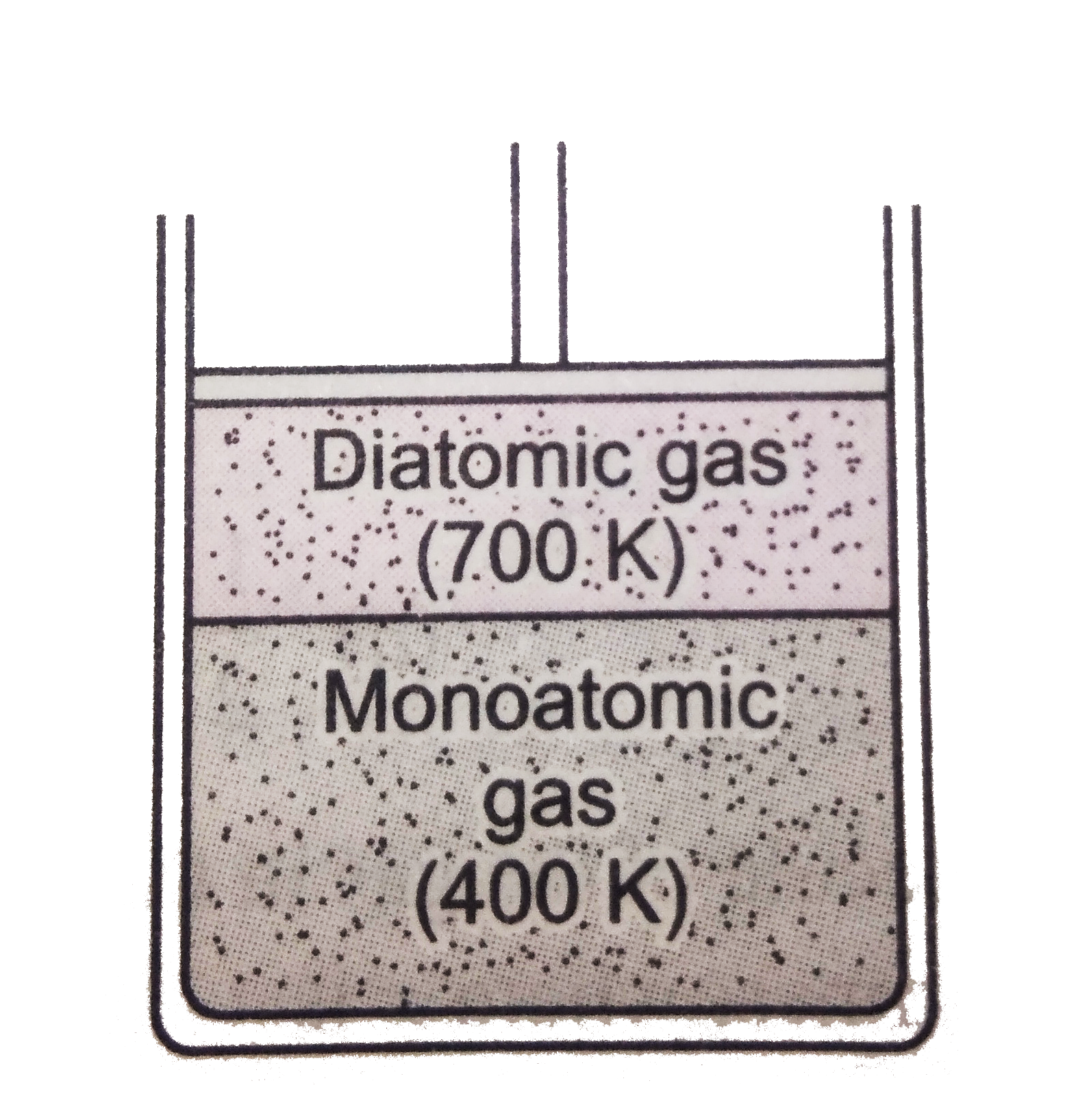 04:59View Solution
04:59View SolutionA spray gun is shown in the figure where a piston pushes air out of a nozzle. A thin tube of uniform cross section is connected to the nozzle. The other end of the tube is in a small liquid container. As the piston pushes air through the nozzle, the liquid from the container rises into the nozzle and is sprayed out. For the spray gun shown, the radii of the piston and the nozzle are 20mm and 1mm respectively. The upper end of the container is open to the atmosphere.
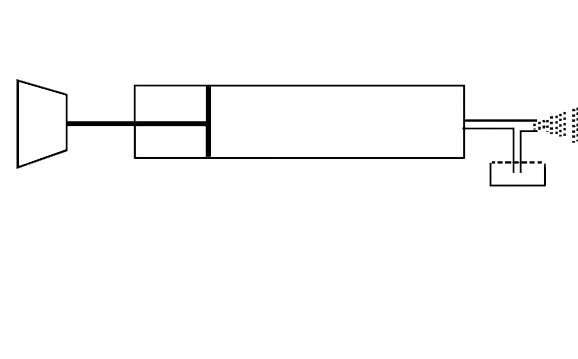
If the piston is pushed at a speed of `5mms^-1`, the air comes out of the nozzle with a speed of06:44View SolutionA spray gun is shown in the figure where a piston pushes air out of a nozzle. A thin tube of uniform cross section is connected to the nozzle. The other end of the tube is in a small liquid container. As the piston pushes air through the nozzle, the liquid from the container rises into the nozzle and is sprayed out. For the spray gun shown, the radii of the piston and the nozzle are 20mm and 1mm respectively. The upper end of the container is open to the atmosphere.

If the density of air is `rho_a`, and that of the liquid `rho_l`, then for a given piston speed the rate (volume per unit time) at which the liquid is sprayed will be proportional to06:44View SolutionThe figure shows a circular loop of radius `a` with two long parallel wires `(numbered 1 and 2)` all in the plane of the paper . The distance of each wire from the centre of the loop is `d`. The loop and the wire are carrying the same current `I`. The current in the loop is in the counterclockwise direction if seen from above.
(q) The magnetic fields(B) at `P` due to the currents in the wires are in opposite directions.
(r) There is no magnetic field at `P`.
(s) The wires repel each other.
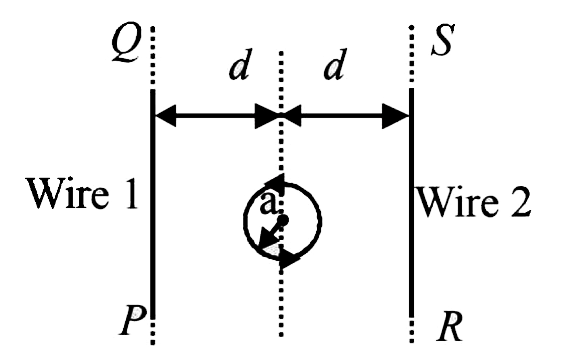
(4) When `d~~a` but wires are not touching the loop , it is found that the net magnetic field on the axis of the loop . In that case07:51View SolutionThe figure shows a circular loop of radius `a` with two long parallel wires `(numbered 1 and 2)` all in the plane of the paper . The distance of each wire from the centre of the loop is `d`. The loop and the wire are carrying the same current `I`. The current in the loop is in the counterclockwise direction if seen from above.
(q) The magnetic fields(B) at `P` due to the currents in the wires are in opposite directions.
(r) There is no magnetic field at `P`.
(s) The wires repel each other.
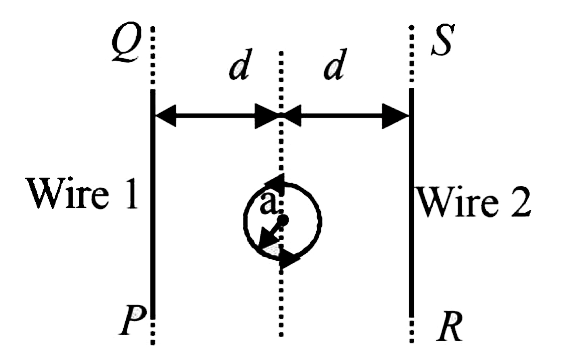
(5) Consider `dgtgta`, and the loop is rotated about its diameter parallel to the wires by `30^(@)` from the position shown in the figure. If the currents in the wire are in the opposite directions, the torque on the loop at its new position will be ( assume that the net field due to the wires is constant over the loop).07:51View Solution
SECTION -2 COMPREHENSION TYPE questions and complete solutions for chapter JEE ADVANCED of JEE ADVANCED PREVIOUS YEAR of Class 12
All Exercises from JEE ADVANCED Class 12 PHYSICS JEE ADVANCED
- MULTIPLE CHOICE QUESTIONS
- PART I : PHYSICS (SECTION -1)
- PART I : PHYSICS (SECTION -2)
- PART I : PHYSICS (SECTION -3)
- PART I : PHYSICS (SECTION 1)
- PART I : PHYSICS (SECTION 3)
- Part I : PHYSICS (Section 3)Paragraph 2
- PART I: PHYSICS SECTION-2: (Paragraph Type)
- PART I: PHYSICS SECTION-3: (Paragraph Type)
- PART I: PHYSICS Section-3:(Matching List Type)
- PART I: PHYSICS (SECTION-1) (One or more options correct Type)
- PART-1 PHYSICS (SECTION 1 )
- PART-1 PHYSICS (SECTION 2 )
- PART-1 PHYSICS (SECTION 3 )
- PHYSICS
- PHYSICS SECTION - I : Single correct Answer Type
- PHYSICS SECTION - II : Multiple correct Answer Type
- PHYSICS SECTION - III Integer Answer Type
- PHYSICS SECTION - IV Matrix Match Type
- SECTION - 1 (ONE OR MORE THAN ONE OPTIONS CORRECT TYPE)
- SECTION - 1 (ONLY ONE OPTION CORRRECT TYPE)
- Section - I Single correct Answer Type
- Section - II (Multiple correct Answer Type)
- Section - III (Paragraph Type)
- Section - IV (Integer Answer Type)
- Section -(III) (Paragraph type)
- SECTION -1
- SECTION -2
- SECTION -2 ( ONE INTEGER VALUES CORRECT TYPE)
- SECTION -2 COMPREHENSION TYPE
- SECTION -3 (MATCHING LIST TYPE)
- Section -IV (Integer type)
- Section -IV (matrix type)
- SECTION 1
- SECTION 2
- SECTION 3 PARAGRAPH 3
- Section I : Single Correct Answer Type
- Section II : Paragraph Type
- Section III : Multiple Correct Answer(s) Type
- Section-1
- Section-2
- SECTION-I (Single correct Choice Type )
- Section-I (single correct choice type)
- SECTION-I( Single Correct Choice Type )
- Section-II (Integer type)
- SECTION-II ( Multiple Correct Choice Type )
- SECTION-II (Multiple correct Choice Type )
- Section-II (Multiple correct choice type)
- SECTION-III ( Comprehension Type )
- SECTION-III (Comprehension Type )
- Section-III (Paragraph)
- SECTION-IV (Integer Answer Type )
- SECTION-IV( Matrix-Match Type )
